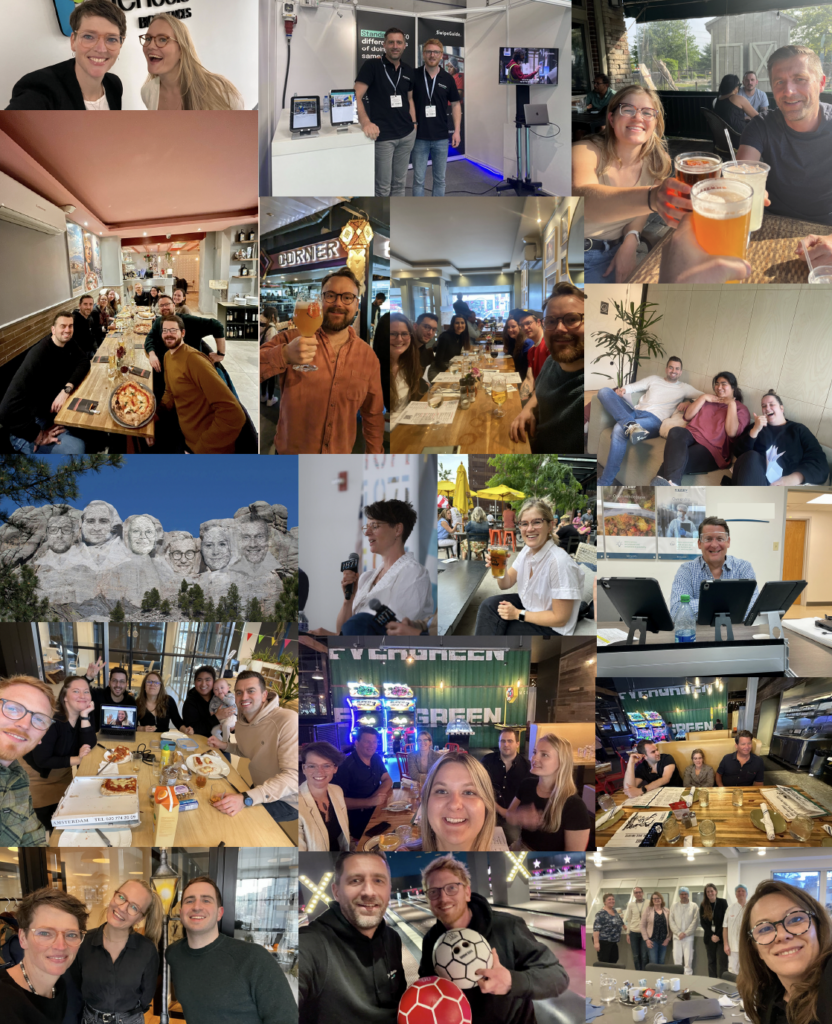Meet Willemijn Schneyder from SwipeGuide
Q: Could you introduce yourself and your company?
A: My name is Willemijn Schneyder, and I’m the founder of SwipeGuide. We started the company in 2016 to revolutionize how people work and learn on the frontline. Our focus is on the digitization of manufacturing processes, streamlining the way knowledge is shared and utilized in manufacturing environments. SwipeGuide is an incredibly easy-to-use frontline training and enablement platform. Our platform empowers companies to capture and standardize their knowledge assets, enabling them to put this knowledge into action across the organization efficiently. This contributes significantly to reducing downtime, lowering labor costs, and enhancing operational efficiencies.
Q: What inspired the creation of SwipeGuide?
A: The genesis of SwipeGuide is a classic startup tale. It began with an exploration into improving after-sales service support during our thesis work. My co-founders and I noticed that a significant percentage of after-sales issues stemmed from customers not understanding how to use products. This observation sparked the idea that if there’s a market for resolving support queries, there should also be a market aimed at preventing these queries and product returns in the first place.
Our journey evolved as we developed our product. We recognized the complexity of content management systems and their ineffectiveness without a simplified approach to instruction design. One of my co-founders, an instruction designer, highlighted the need for our software to communicate the essential knowledge for tasks effectively. This led us to design a unique knowledge format that enhances user performance. Interestingly, our initial customer base came from factories, which prompted us to investigate this use case further. We discovered that our product’s simplicity and effectiveness in creating instructions were perfectly aligned with the continuous improvement processes on manufacturing frontlines. This realization led us to pivot and fully concentrate on serving the manufacturing industry two years into our journey.
Choosing Plug and Play as an Investor
Q: How did SwipeGuide decide on Plug and Play for funding?
A: Our journey to securing funding began with informal investors, who played a crucial role in launching SwipeGuide. As we progressed to the seed stage, the focus shifted to achieving product-market fit, exploring various sales avenues, and identifying markets where our product could deliver significant impact, value, and adoption. This phase led us to partner with a Dutch B2B SaaS fund. As our company evolved, particularly after pivoting to focus on the manufacturing sector, the need for specialized investors with a robust network in this new industry became apparent. We compiled a list of potential investors who met our criteria, emphasizing both capital and network. Plug and Play stood out due to its extensive global network of innovation hubs and corporate partnerships seeking innovation. Their reach and reputation for fostering innovation on a global scale made them an attractive choice for SwipeGuide.
Q: What was the approach to connecting with Plug and Play?
A: Our connection to Plug and Play was facilitated through an introduction by Speedinvest. In strategizing our investment journey, we aimed to assemble a group of investors whose networks could provide both market access and expertise. Speedinvest played a pivotal role in this process, connecting us with the right individuals within Plug and Play’s supply chain innovation team. This introduction was instrumental in aligning SwipeGuide with an investor that could support our growth and expansion goals.
How a Founder Gets Funded
Q: Can you describe the process of securing funding with Plug and Play?
A: The process involved several key steps, starting with an introductory meeting to share our product-market fit, operational metrics, and strategic vision. This was followed by a qualification call, expanding the dialogue to include our leadership team and Plug and Play’s broader investment group, where we discussed our multi-year plan and investment thesis in detail. After these discussions, we formally invited Plug and Play to participate in our funding round, while simultaneously coordinating with other investors. Negotiations focused on the value beyond capital, such as public relations support, brand recognition enhancement, and collaboration with corporate sponsors in the supply chain sector to build connections and success stories.
Q: What were you aiming to raise, and who led the round?
A: We aimed to raise $5 million in our second round, with Speedinvest leading and taking a majority stake. The entire process, from the initial contact with Plug and Play to closing the deal, spanned approximately four months, culminating in a closure on April 1st, which interestingly fell on April Fool’s Day.
Q: How intensive was the fundraising process?
A: Fundraising is inherently time-consuming and requires meticulous preparation. Our approach included extensive prep work, leveraging the last 12 months of data to strategically plan our Q4 fundraising. We also focused on creating a “perfect storm” around our brand, enhancing our visibility through awards, publications, and profiles on platforms like Crunchbase. This groundwork, combined with having our data room and equity story prepared in advance, allowed us to navigate the fundraising process efficiently, completing it in a significantly shorter time frame than the typical nine months often expected in Europe.
Plug and Play’s Assistance Beyond Funding
Q: Besides financial investment, what other forms of support does Plug and Play offer?
A: The value Plug and Play brings extends far beyond mere financial investment. For SwipeGuide, the partnership with Plug and Play has been about much more than just a minority stake in our company. The most significant benefit has been access to their extensive network, which has played a crucial role in increasing our brand awareness, enhancing our profile, and acquiring new customers, especially in new markets. Through our partnership, Plug and Play has facilitated our participation in supply chain summits and other events, enabling us to showcase our solutions and success stories with their clients. This exposure has been instrumental in accessing new clients and markets, promoting our brand, and establishing SwipeGuide as a thought leader in our space.
Q: How has your relationship with Plug and Play evolved post-investment?
A: Our relationship with Plug and Play remains strong and dynamic, even three years after the initial investment. The operational execution on their part is commendable, with various teams within Plug and Play ready to support our endeavors, whether it be connecting us with potential use cases, trade shows, or events that can benefit SwipeGuide. The quality of the partnership we’ve built with Plug and Play underscores that the success of such relationships hinges on mutual effort. By actively engaging and investing in this relationship, we’ve been able to leverage Plug and Play’s vast resources and network to our advantage, proving that the quality and effort put into the partnership can yield significant returns.
Areas for Improvement in Plug and Play’s Support
Q: Are there areas where Plug and Play could improve, based on your experience?
A: While our partnership with Plug and Play has been largely positive, navigating their extensive organization posed certain challenges initially. The vastness of Plug and Play’s network and operations meant that finding our footing and the right team to collaborate with took some time. This is a common hurdle in large organizations, where making informal contacts and building relationships in a remote setting can be daunting. After securing the investment, translating our agreements into action was not straightforward. It required about six months to identify an operational team within Plug and Play that fully grasped what we were doing and could direct us effectively. During this period, we experienced as many misses as hits in terms of being connected to relevant leads, suggestions, or events within their network.
Furthermore, the transition from the investment team to the operations team meant reestablishing our connections and understanding anew, which can be a repetitive and time-consuming process. The geographical spread of their teams across various cities globally added another layer of complexity to maintaining clear and consistent communication.
In summary, while Plug and Play offers significant value through its global network and resources, enhancing the clarity and efficiency of navigating this vast ecosystem could further improve the experience for startups like ours.
Advice for Engaging with Plug and Play
Q: What advice do you have for startups looking to engage with Plug and Play?
A: For startups seeking to connect with Plug and Play, I have two key pieces of advice. First, the most effective way to engage with Plug and Play is through an introduction by one of their existing portfolio companies. Such referrals can significantly enhance your credibility and streamline the qualification process. Second, it’s crucial to conduct thorough research before reaching out. Given Plug and Play’s vast organization and the diverse focus areas of its different teams, understanding whom to approach can save you considerable time and effort. This preparation ensures you’re connecting with the team that’s most relevant to your startup’s stage and needs.
Also, consider the stage of your company when seeking engagement. Plug and Play tends to offer more value to early-stage companies that can benefit from innovation projects and launching customers. For more mature startups primarily focused on selling products, the value added might not be as significant. Tailoring your approach based on these insights can optimize your engagement with Plug and Play and ensure a more fruitful collaboration.



